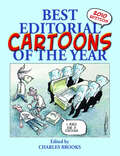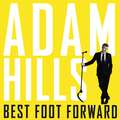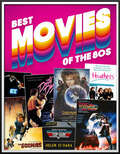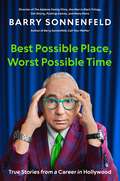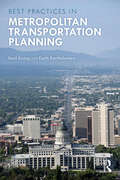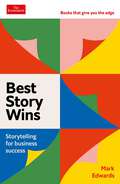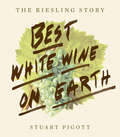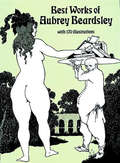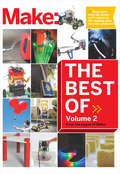- Table View
- List View
Best Buds Forever (Craftily Ever After #7)
by Martha MakerWhen Emily discovers an empty lot that used to be a community garden, she and her crafty friends make it bloom once again in this seventh book of the Craftily Ever After chapter book series.Emily Adams learns that an empty dirt lot in town used to be a beautiful garden but now it&’s about to be paved over. So, she decides to take action. Emily and her three crafty friends, Maddie, Bella, and Sam decide the best way to save the old garden is to create a new one! But first they have to get the neighborhood on board. They research why gardens are great for the environment and the community, and they present the information to their friends, family, and neighbors. The last person they have to convince is the mayor himself. The friends know that no matter what happens, they&’ll be best buds forever…but will the mayor like their plan? With easy-to-read language and illustrations on almost every page, the Craftily Ever After chapter books are perfect for emerging readers.
Best Development Practices: Doing the Right Thing and Making Money at the Same Time
by Reid EwingThe author draws upon case examples of some of today's most acclaimed developments in this book, and recommends best practice guidelines to help developers create vibrant, livable communities-and still make money. For years, Florida's planners and developers have had to deal with some of the most difficult growth management problems. Now planners and developers across the nation can benefit from the valuable lessons Florida offers on combating urban sprawl. Ewing first searched the state for the best contemporary developments, then distilled their lessons into guidelines for directing new development and assessing the quality of existing development. The 43 practices outlined in this exciting book cover four areas of development-land use, transportation, the environment, and housing. They apply to a broad range of development projects, including small planned communities, residential subdivisions, and commercial centers. The book's recommendations are based upon the experiences of successful developers and supported by empirical research. The proof lies in the compelling real-world examples Ewing highlights throughout the text. Illustrated with dozens of photographs and written in a lively style, this book is must reading for all those seeking better ways to plan and design communities. Developers will find proven, feasible land development regulations and benchmarks against which to evaluate development proposals.
Best Editorial Cartoons of the Year: 2010 Edition (Best Editorial Cartoons of the Year)
by Charles BrooksA look back at the year 2009 through over 400 editorial cartoons—including winners of the Pulitzer Prize, the Thomas Nast Prize, and other major awards. Full of clever commentary on the major events of 2009, this collection of more than 400 cartoons covers a range of topics and viewpoints from liberal to conservative. Pulitzer Prize winners and other leading editorial cartoonists cover, among other news, the Obama administration, the disastrous economic crash, government bailouts, and healthcare reform. These controversial subjects are presented with quick wit, sharp observation, and a healthy dose of humor in this book, part of the series of annuals first published over fifty years ago. From Sarah Palin to Rod Blagojevich, many politicians make appearances—as do figures from sports, media, foreign affairs, and more. No subjects are off limits, and all mistakes and failures are fair game, because even if history repeats itself, there is often someone new to blame for it. Praise for the series &“Powerful and pointed.&” —International Journal of Comic Art &“The value of this series grows right along with it as the chronicle of the &‘hot&’ topics of each year.&” —East Texas Historical Association
Best Foot Forward
by Adam HillsAdam Hills was a quiet primary school kid with a prosthetic foot, who did all his homework and only spoke when spoken to. His dad sparked in him a love of comedy and together they'd spend hours watching and listening to the greats like Peter Sellers and Mel Brooks, so, when it was Adam's turn to speak, he made sure he was funny. Once he hit high school, comedy was Adam's obsession (along with a deep love for the South Sydney Rabbitohs). While his mates were listening to Iron Maiden and AC/DC, he was listening to Kenny Everett and Billy Connolly. And when a report card came home with a comment praising his sense of humour, he was far prouder of that than his grades (his mum not so much). Adam's shyness and his missing foot never held him back, though wearing thongs was tricky. While other teens snuck off to meet girls and drink cheap booze, Adam snuck off to see a young Jim Carrey perform. After that, a steady diet of Rodney Rude, Vince Sorrenti and Robin Williams led this sheltered, virginal university student from The Shire to his first stand-up open mic night on his 19th birthday. In Best Foot Forward, Adam describes his early years on the Australian comedy scene sharing gigs with Steady Eddy and Jimeoin, how he coped the first time he died on stage, his early-morning apprenticeship in radio, touring the world's comedy festivals, the magic of Spicks and Specks and his hosting gig for the 2008 Paralympics that led to his ongoing hit UK TV show The Last Leg. Whoopi Goldberg, Barry Humphries, Billy Connolly, Kermit the Frog - Adam's learned from the best. This charming, witty memoir is a lesson in following your heart, being positive and discovering that what makes you different also makes you unique.
Best Friends Forever
by Rachael Hale MckennaBest-selling photographer and author Rachael Hale McKenna is world renowned for her animal and baby portraits. Now--for the first time ever--she combines her two favorite subjects in this irresistible collection of images featuring adorable babies snuggled up to their lovable furry companions, from puppies and kittens to bunnies and ducklings, and more! With uplifting quotes on friendship sprinkled throughout, Best Friends Forever makes a heartwarming gift for newborns and their parents, animal lovers, and anyone's own BFF.
Best Friends Forever: Christopher Hart's Draw Manga Now!
by Christopher HartFocusing on the dramatic character friendships (and sometimes rivalries) that are central to any manga narrative, Best Friends Forever teaches readers how to draw characters at slumber parties, school, and parties together, as well as combining character types that complement each other. After an introduction to these elements, readers will have a chance to follow along Hart's in-depth step-by-steps, and will even be invited to draw on their own, right in the book's pages.
Best Hair Book Ever!: Cute Cuts, Sweet Styles and Tons of Tress Tips
by Editors of Faithgirlz! and Girls' LifeBlow away the blues of a bad hair day and embrace your unique style! Whether you&’re pinning an up-do for a party or styling your hair for picture day, trust the tips and tricks of Faithgirlz to always have an amazing hair day.We&’ve all had bad hair days—be it hair that won&’t curl or is way?too?curly, a cut that won&’t grow out fast enough, or a do that just feels like an absolute don&’t even after hours of pinning and spraying.Best Hair Book Ever!:Is perfect for preteens and tweens 8 – 12 years oldFeatures fun, easy styles that can be replicatedOffers advice on grooming, hair care, and styleMakes a great birthday, Christmas, back to school, or holiday giftPut down that straightening iron and pick up this book to find the best style or cut for you! With killer tricks and tips you can have amazing hair every day.
Best Homes of the 1920s
by Standard Homes CompanyIt has required years of painstaking effort...to bring before prospective home builders the hundreds of practical, money saving ideas offered by this system... A little study of each plan shown will convince any thoughtful person that these are, in reality, the most carefully planned homes in America. -- Better Homes at Lower CostFaithfully reprinted from the Standard Homes Company's popular Better Homes at Lower Cost, this collection of early twentieth-century house plans was created with a simple system of standardization that allowed 1920s-era home builders to reduce construction costs while maintaining the integrity of an attractive and soundly built abode. Scores of excellent photographs, drawings, and floor plans depict seventy-seven meticulously detailed homes of wood, brick, stucco, and stone. From the substantial beauty of the eight-room "Homestead" and the classic colonial "Cambridge" to the spacious Spanish-style "Ponce de Leon," this is a rare and delightful time capsule for builders, home preservationists, architects, and readers interested in nostalgia and vintage home illustrations.
Best Movies of the 80s
by Helen O'HaraTravel back in time to the most bodacious movie decade ever!Don't miss this trip through the movies that defined the ’80s era. Packed with photos and memorabilia of Hollywood stars, this collection of classic cinema blockbusters offers summaries, release dates, trivia, and fun facts on each motion picture. We'll cover the invention of massive-budget action films, the Brat Pack, and even popular foreign flicks of the day. Nobody puts this book in the corner—you’ll be donning your Ray-Bans and immersing yourself in gnarly nostalgia from the neon-colored 1980s in no time!
Best Possible Place, Worst Possible Time: True Stories from a Career in Hollywood
by Barry SonnenfeldOne-of-a-kind filmmaker Barry Sonnenfeld tells stories only he can tell, from his blockbuster career with iconic actors, studio execs, and producers. His humor and insight provide an inside glimpse into how Hollywood really works, or how it doesn&’t.Best Possible Place, Worst Possible Time delivers a cavalcade of sometimes baffling, often enlightening, and always funny stories about Sonnenfeld&’s many films and television shows. From battling with studio executives and producers to bad-script-solving on set to coaxing actors into finding the right light and talking faster, Sonnenfeld provides an entertaining master class in how to make commercial art in the face of constant human foible. Over four decades in Hollywood, the mega-franchises include The Addams Family and Men in Black; the critical favorites, Get Shorty and Pushing Daisies; the icons, Will Smith, John Travolta, and Michael Jackson; and the projects that got away, Forrest Gump, Ali, and anything starring Jim Carrey. The true stories escalate from surreal to outrageous to unbelievable. And then there&’s magic hour. But you&’ll never see Hollywood the same way again.
Best Practices for Teaching Reading: What Award-Winning Classroom Teachers Do
by Randi StoneFollowing the successful format of the companion volumes for teaching writing, mathematics, science, and social studies, Best Practices for Teaching Reading presents firsthand accounts of outstanding instructional strategies and lessons for teaching reading to students in both elementary and secondary school. Randi Stone brings readers into the classrooms of more than twenty-five award-winning teachers who share their unique and creative strategies for reaching elementary and secondary learners with diverse learning styles and abilities. From getting fourth-grade students excited to study Shakespeare to creating “wonder journals” to incorporating reading in the math classroom, these teachers have tried it all!With forty classroom-tested strategies, Best Practices for Teaching Reading provides practical guidance for building students’ decoding and vocabulary skills while developing their comprehension and motivation for reading. This collection of best practices presents useful tips in getting students to:· Get excited about reading· Make connections between different texts· Become effective writers as well as readers· Use literacy skills across the curriculumVeteran and new teachers alike will find an abundance of fresh ideas to teach reading while helping students build confidence, increase academic achievement, and develop critical thinking skills.
Best Practices in Metropolitan Transportation Planning: New Advances, Approaches, And Best Practices
by Reid Ewing Keith BartholomewPlanning at a metropolitan scale is important for effective management of urban growth, transportation systems, air quality, and watershed and green-spaces. It is fundamental to efforts to promote social justice and equity. Best Practices in Metropolitan Transportation Planning shows how the most innovative metropolitan planning organizations (MPOs) in the United States are addressing these issues using their mandates to improve transportation networks while pursuing emerging sustainability goals at the same time. As both a policy analysis and a practical how-to guide, this book presents cutting-edge original research on the role accessibility plays - and should play - in transportation planning, tracks how existing plans have sought to balance competing priorities using scenario planning and other strategies, assesses the results of various efforts to reduce automobile dependence in cities, and explains how to make planning documents more powerful and effective. In highlighting the most innovative practices implemented by MPOs, regional planning councils, city and county planning departments and state departments of transportation, this book aims to influence other planning organizations, as well as influence federal and state policy discussions and legislation.
Best Story Wins: Storytelling for Business Success (Economist Books)
by Mark EdwardsAn inspiring, practical, and timely new guide on how to harness the power of storytelling in our communications at work. Whether you're standing up in front of a crowd at a conference or chatting with a colleague in an elevator, storytelling is the most effective way to get your point across. It works in ninety-second Superbowl television spots, it works in ten-second social media formats, and it works in that email you have to fire off in five seconds flat. Why? The short answer is that people don't make decisions based on logic. They make decisions based on emotions. To persuade, influence, and inspire, you need to make an emotional connection. And storytelling is the best way of doing that. Journalist-turned-business coach Mark Edwards has developed his own methodology for telling compelling stories at work. Best Story Wins shows how storytelling will make better communicators of us all.
Best White Wine on Earth: The Riesling Story
by Stuart PigottA celebrated wine journalist presents a comprehensive, entertaining primer on one of the most beloved wines of our time: Riesling. Diverse, drinkable, aromatic, and refreshing, Riesling is a chameleon among white wines. From its food-friendly flavor and favorable price point to its ability to be either bone-dry or honey-sweet, there are very good reasons to argue that Riesling is not just a popular wine of the moment, but the finest white of our time. In Best White Wine on Earth, wine journalist and Riesling enthusiast Stuart Pigott extols the virtues of his favorite varietal and explores the history behind this magnificent grape. Traveling to the great Riesling-producing regions of the world—from North America to Europe, Australia, New Zealand, and South America—Pigott provides tasting notes, top-rated recommendations, and fascinating insights into how the wine is made, all while making an impassioned case that it is, truly, the best white on earth. Written simply enough for a novice, but with enough expertise and insight to satisfy the most sophisticated collector, this is a must-have guide for any white wine enthusiast.
Best Wishes, Warmest Regards: The Story of Schitt's Creek
by Daniel Levy Eugene LevyThis beautifully produced, lavishly illustrated book is the ultimate celebration of the series, the town, the characters, and the state of mind that is Schitt's Creek. Capturing the essence and alchemy of all six seasons of what is now considered to be one of the most groundbreaking comedy television series of the last decade, Best Wishes, Warmest Regards is a gift to fans everywhere who have made the show their own.Included are character profiles from the cast of Johnny, Moira, David, and Alexis, and all of the characters that populate the town, major moments from Moira's endorsement of Herb Ertlinger Winery, to Patrick and David's first kiss, to Cabaret and the Rose Family Christmas episode. Also included are special features, such as the complete, illustrated catalogs of David's knits and Moira's wigs, Moira's vocabulary, Alexis's adventures, and behind-the-scenes moments from Dan and Eugene Levy and the cast of Schitt's Creek.
Best Wishes, Warmest Regards: The Story of Schitt's Creek
by Daniel Levy Eugene LevyThe official tie-in book for the beloved, nine-time Emmy® Award-winning series Schitt's Creek. This beautifully produced, keepsake coffee-table book is the ultimate celebration of the series, the town, the characters, and the state of mind that is Schitt's Creek. Capturing the essence and alchemy of all six seasons of what is now considered to be one of the most groundbreaking comedy television series of the last decade, Best Wishes, Warmest Regards is a gift to fans everywhere who have made the show their own. <P><P>Included are character profiles from the cast of Johnny, Moira, David, and Alexis, and all of the characters that populate the town, major moments from Moira's endorsement of Herb Ertlinger Winery, to Patrick and David's first kiss, to Cabaret and the Rose Family Christmas episode. Also included are special features, such as the complete, illustrated catalogs of David's knits and Moira's wigs, Moira's vocabulary, Alexis's adventures, and behind-the-scenes moments from Dan and Eugene Levy and the cast of Schitt's Creek. <P><P><b>A New York Times Best Seller</b>
Best Workbasket
by Krause PublicationsKnitting and crocheting have never been so hot - even celebrities like Julia Roberts and Vanna White can be found with a needle or hook. Today's top knitting and crochet designers present updated patterns from Workbasket magazine in this perfect instruction book for anyone wanting to learn these popular crafts! Features 35 projects as they originally appeared, including sweaters, scarves, hats, mittens, and vests. Each project is updated with slight design alterations and then created with today's new specialty yarns and colors.
Best Works of Aubrey Beardsley
by Aubrey BeardsleyIn the brief span of his life and career, Aubrey Beardsley (1872-98) galvanized public attention in 1890s London with his exotic renderings of subjects, which often projected the sensual and the grotesque. This splendid volume brings together the best of Beardsley's work -- a rich selection ranging from illustrations for Laclos's Les Liaisons Dangereuses and Balzac's La Comédie Humaine to magazine cover designs, book plate silhouettes, title-page ornaments, and delightful mini-portraits of major composers. Also included are two photographs of the artist, consisting of private portrait studies by Frederick H. Evans.Over 180 beautifully reproduced black-and-white plates capture the uniqueness of Beardsley's vision and reveal the seductive power of his art. Among the illustrations are brilliantly conceived vignettes from Le Morte D'arthur, Venus and Tannhäuser, Salome, and Lucian's True History as well as enchanting creations for The Yellow Book (an influential British arts quarterly), and much more.Characterized by bold black masses, elongated shapes, and sensually provocative figures, these works are the product of a remarkable individual style that transformed the art of illustration. Reproduced here in an inexpensive high-quality format, they are certain to thrill not only Beardsley enthusiasts but anyone interested in the early years of modern graphic art.
Best iPhone Apps: The Guide for Discriminating Downloaders
by J. D. BiersdorferWith over 250,000 apps to choose from in Apple's App Store, you can make your iPhone or iPod Touch do just about anything you can imagine -- and almost certainly a few things you would never think of. While it's not hard to find apps, it is frustratingly difficult to find the the best ones. That's where this new edition of Best iPhone Apps comes in. New York Times technology columnist J.D. Biersdorfer has stress-tested hundreds of the App Store's mini-programs and hand-picked more than 200 standouts to help you get work done, play games, stay connected with friends, explore a new city, get in shape, and more. With your device, you can use your time more efficiently with genius productivity apps, or fritter it away with deliriously fun games. Play the part of a local with brilliant travel apps, or stick close to home with apps for errands, movie times, and events. Get yourself in shape with fitness programs, or take a break and find the best restaurants in town. No matter how you want to use your iPhone or iPod Touch, Best iPhone Apps helps you unlock your glossy gadget's potential. Discover great apps to help you: Get work done Connect with friends Play games Juggle documents Explore what's nearby Get in shape Travel the world Find new music Dine out Manage your money ...and much more!
Best in Show: (dog Photography Book For Dog Lovers, Dog Show Photo Book)
by Dolly FaibyshevBest in Show is a collection of photographs of well-groomed and award-winning dogs by New York City–based photographer Dolly Faibyshev. The images from the Westminster Kennel Club Dog Show and beyond focus on the unique—and often humorous—relationship between each dog and their handler. Dolly Faibyshev focuses on kitsch, irony, and the larger than life human and canine characters that make up Best in Show. The result is a colorful, vibrant, campy, and satirical take on this specific slice of Americana. • The colorful, closely cropped juxtapositions of each coiffed canine contestant and their dedicated human are both humorous and charming. • Sure to delight fans of all breeds of dogs• A universal and ideal book for all canine lovers with a sense of humorBest in Show captures a specific subculture of dog devotees primarily from the infamous Westminster Kennel Club Dog Show at Madison Square Garden in New York.• A perfect book for anyone who is completely and totally obsessed with dogs and the Westminster Kennel Club Dog Show• Photographers and contemporary art lovers will also love this celebration of Dolly Faibyshev's work• Great for fans of The Dogist: Photographic Encounters with 1,000 Dogs by Elias Weiss Friedman, Dogs by Lewis Blackwell and Tim Flach, and Underwater Dogs by Seth Casteel
Best in Show: 24 Appliqué Quilts for Dog Lovers
by Carol ArmstrongPortraits in Appliqué that Practically Sit Up and Say Woof Show off 24 dog breeds at their most appealing with these charming little appliqué portrait quilts Save steps with Carol's easy light box appliqué technique Give your canine friends added depth and dimension with relaxed, random quilting designs Each pattern includes full-size appliqué templates From the basset hound's mournful sincerity to the corgi's lively alertness, Carol Armstrong's designs capture that certain something that gives each breed its characteristic look. Now you can immortalize your own canine companion with her easy appliqué and quilting techniques. *Important Note about PRINT ON DEMAND Editions: All sales are final - PODs are non-returnable and non-refundable. This title will be printed after purchase and will arrive separately from any in-stock items. Allow minimum 2 weeks for USA delivery, and additional 2 weeks for international shipments. Expedited shipping not available. Print quality will vary from the original offset-printing edition and will be printed on uncoated (non-glossy) paper. The information presented is the same as the most recent printed edition. Pattern pullouts (if applicable) have been separated and presented as single pages.
Best of Barbie: Four Decades of America's Favorite Doll
by Sharon KorbeckFeaturing striking photographs and lively, insightful commentary and histories, The Best of Barbie is a full-color visual feast that novice and experienced collectors alike will treasure. Scattered throughout the book are trivia facts that test the reader's knowledge of America's favorite doll. Plus, accompanying each photo is a handy identification and value info bar - facts readers need at a glance. With complete descriptions, 300 magnificent color photos and more than 1,200 price listings, collectors, appraisers, buyers and fans will have the tools to identify the most influential Barbie Dolls including Barbie #1 Ponytail Style, Bubblecut Barbie, Barbie Fashion Queen, American Girl and many more.
Best of Interweave Crochet: A Collection of Our Favorite Designs
by Marcy SmithInside The Best of Interweave Crochet, you'll discover the very best patterns by the top designers of the first 6 years of Interweave Crochet magazine.Marcy Smith, editor of Interweave Crochet magazine, has compiled the most popular pieces and expert advice from the magazine's first six years into one highly sought-after collection.From Kathy Merrick's color-rich Babette's Blanket to Kristin Omdahl's shapely Infinity Shawl to Lily Chin's flattering Lace Dress, these designer projects are both original and stylish. Each pattern includes detailed instructions accompanied by helpful charts, detailed photography, yarn recommendations, and more. You'll also find the in-depth crochet instructions, tips, and techniques that go beyond the basics to include variations on the basic stitches, garment shaping, Tunisian crochet, lacework, colorwork, and more.The Best of Interweave Crochet offers all the tips and techniques that Interweave Crochet readers know and love. Whether you're picking up a hook for the first time or you're a long-time crocheter, you'll love the twenty unique and popular projects and expert guidance all in one accessible volume.
Best of Interweave Knits: Our Favorite Designs From The First Ten Years
by Ann BuddCelebrating 10 years of innovative and appealing garment designs from Interweave Knits, this must-have collection is comprised of 30 scarves, stoles, cardigans, pullovers, vests, jackets, tops, and totes that have stood the test of time. Representing the creative work of 26 notable designers, it includes gorgeous photography, a dozen favorite "Beyond the Basics" columns that provide in-depth information on essential techniques, and step-by-step instructions through every aspect of knitting and finishing. Even relatively inexperienced knitters will find this archive of classic design to be an indispensable reference tool for years to come.
Best of Make: 65 Projects and Skill Builders from the Pages of Make: (Volume #2)
by The Editors of Make:After ten years, Make: has become one of most celebrated magazines to hit the newsstands, and certainly one of the hottest reads. If you're just catching on to the Maker Movement and wonder what you've missed, this book contains the best projects and articles from the magazine. Find out what keeps Makers coming back to Make: with this assortment of DIY projects and articles selected by Make:'s editors. Learn to:Outfit your workshop and make some must-have toolsBuild electronic projects from actuators to antennaeMake things with Arduino and Raspberry PiCreate drones and robotsBuild noisemaking projects and musical instrumentsAugment your photo and video capabilitiesMake your own food, soap, ink, and more


